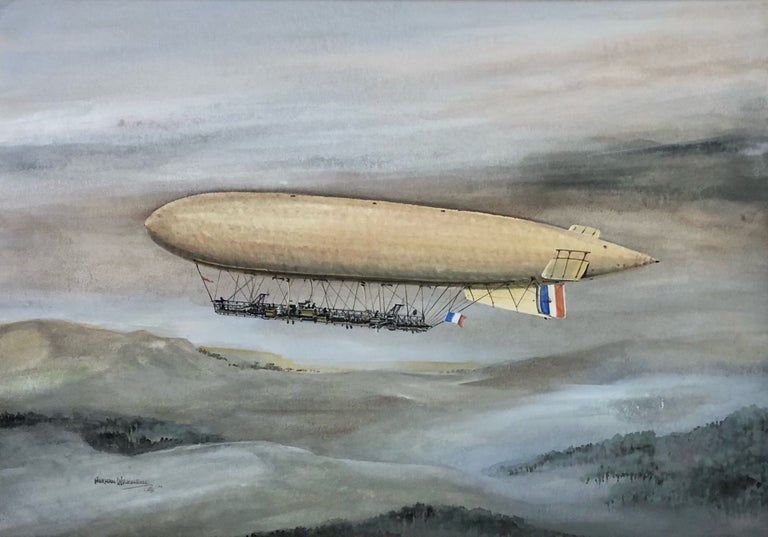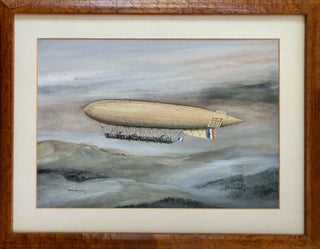Fleurus Airship French Army
1912. Watercolor and ink on heavy wove watercolor paper, 10 5/8 x 15 inches (270 x 380 mm). Signed in black watercolor in the lower right image area. In very good condition with minor surface soiling on the verso. Titled "Verdun" in pencil on the verso in the artist's hand. Adhered on the verso to matboard at the extreme margins with non archival tape. Presented handsomely in a simple, period maple frame. Titled, dated, inscribed and initialed by the artist on a label on the frame back.
Born in Cambridge in 1898 and educated at Southsea School of Art, Norman Wilkinson is known for his graphic art, specifically his British Railway poster images, and also for something quite incredible; Wilkinson revolutionized the art of naval camouflage. Having been assigned to submarine patrols in Dardanelles, Gallipoli, and Gibraltar during WWI as a member of the Royal Navy Volunteer Reserve, Wilkinson was deeply troubled by the unprecedented success the German submarine fleet had torpedoing British ships. He hoped to find a solution to this gaping vulnerability, and in a lightning bolt moment, he had an epiphany that would change everything. Wilkinson says in his autobiography, A Brush With Life (Seeley, 1969), that he realized a ship could be painted to hide its shape against the sea and sky. In his own words, Wilkinson states that the hull of a ship could be camouflaged "not for low visibility, but in such a way as to break up her form and thus confuse a submarine officer as to the course on which she was heading." After some preliminary testing, the theory Wilkinson called "dazzle camouflage" was accepted by British Admiralty and Wilkinson was placed in charge of the naval camouflage unit. The unit, which was headquartered in the basement of the Royal Academy of Arts, consisted of Wilkinson and about two dozen "camoufleurs;" they were artists, students, model makers and consultants, including a zoologist. The dazzle schemes were tested on models and then distributed to artists who were stationed at the docks, where the ships would be painted. At the end of the war Wilkinson was formally declared the inventor of dazzle camouflage and awarded for his contribution.
Wilkinson went on to enjoy a long and celebrated career as a painter of maritime scenes, naval vessels, and warships. He served as the president of the Royal Institute of Painter in Water Colours (RI) from 1936 until 1963 (having been elected a member in 1906); he was elected Honourable Marine Painter to the Royal Yacht Squadron in 1919, and he was a member of the Royal Society of British Artists, the Royal Institute of Oil Painters, the Royal Society of Marine Artists, and the Royal Scottish Society of Painters in Watercolour. In 1918 he was appointed an Officer of the Order of the British Empire (OBE), and a Commander of the Order (CBE) in 1948. In January 1920 he was appointed knight (chevalier) of the Belgian Order of the Crown.
Among the many notable points of interest regarding Wilkinson's career is that his painting Plymouth Harbour, which was commissioned by Cunard White Star Lines for the first class smoking room of the RMS Titanic, was lost at sea when it perished with the ship. Wilkinson had also created a comparable painting entitled The Approach to the New World, which hung in the same location on the Titanic's sister ship, the RMS Olympic. This work may be seen in the 1958 film A Night to Remember in scenes aboard the Titanic, where is served as the stand-in for Plymouth Harbor.
About the Fleurus:
At the outset of WWI in 1914, French airships were made entirely out of non-rigid materials, and it was one of these vessels that would become the first aircraft to carry out an Allied bombing raid from the sky. This was the Fleurus, which had been constructed in the shop at Chalais-Meudon two years earlier in 1912, and the historic raid was the Battle of Verdun.
The gondola and engine of the Fleurus (or C.B.V. as it was officially known), both designed by Clement-Bayard (hence the C.B. designation), were extremely efficient and aerodynamic, due to extensive wind tunnel tests conducted at the Eiffel laboratory. During the last months of peacetime before France entered WWI, the Fleurus was widely demonstrated and participated extensively in Army training maneuvers. It was flown from it's base in Pau on September 23, 1914, and completed a flight to Saint-Cyr in 16 hours, maintaining an average speed of 54 km/h (33.7 mph), which was significantly lower than its maximum velocity. The airship maintained an astonishing altitude of 1000 m (3,281 ft) for the duration of the journey.
There being no official air arm of the French forces at the time, the Fleurus was then considered an Army airship, but by 1917 the Fleuris was five years old and obsolete, so was offered to the Navy, which had expanded to include an airforce. The Fleurus, along with another airship, was designated for training exercises along North Africa’s Mediterranean coast. It was here that the Fleurus would see the end of its days. Ironically, the revolutionary airship, which was built using the groundbreaking foundational engineering of fledgeling air warfare, was destroyed by a more modern version of itself. While grounded in a storage hanger The Fleurus was reduced to ashes in an air raid fire in June of 1918.
The French national insignia, seen here in Wilkinson's painting, had not been adopted at the time of the Fleurus' first flight, but when it was introduced, the Fleurus I C.B.V. was one of the earliest in France to be thus marked. The 1912 Fleurus I airship was commemorated on a Korean postage stamp in 1979.
Item number: 520
Price: $2,400.00
Share:

